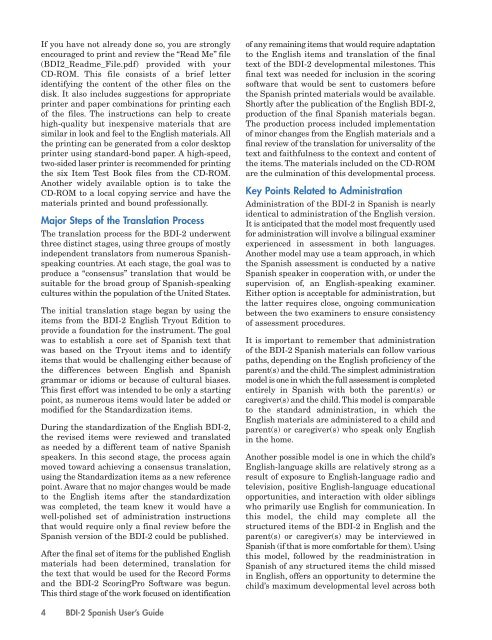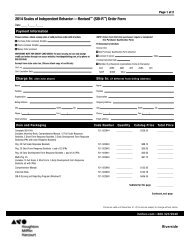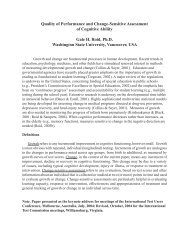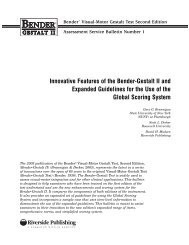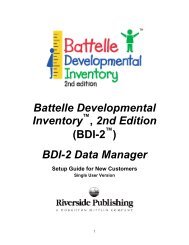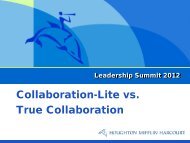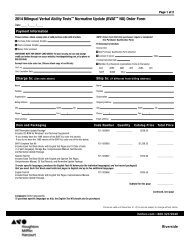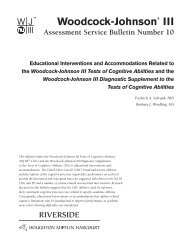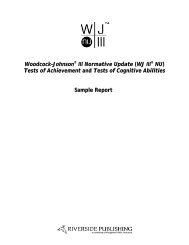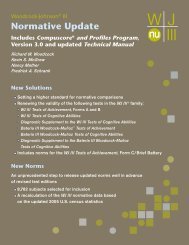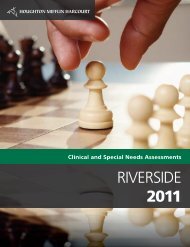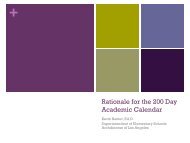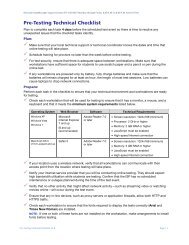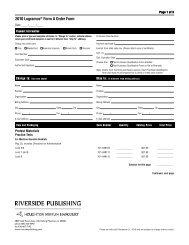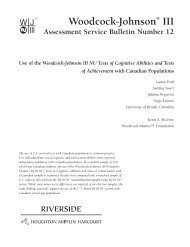User's Guide - Riverside Publishing
User's Guide - Riverside Publishing
User's Guide - Riverside Publishing
You also want an ePaper? Increase the reach of your titles
YUMPU automatically turns print PDFs into web optimized ePapers that Google loves.
If you have not already done so, you are stronglyencouraged to print and review the “Read Me” file(BDI2_Readme_File.pdf) provided with yourCD-ROM. This file consists of a brief letteridentifying the content of the other files on thedisk. It also includes suggestions for appropriateprinter and paper combinations for printing eachof the files. The instructions can help to createhigh-quality but inexpensive materials that aresimilar in look and feel to the English materials. Allthe printing can be generated from a color desktopprinter using standard-bond paper. A high-speed,two-sided laser printer is recommended for printingthe six Item Test Book files from the CD-ROM.Another widely available option is to take theCD-ROM to a local copying service and have thematerials printed and bound professionally.Major Steps of the Translation ProcessThe translation process for the BDI-2 underwentthree distinct stages, using three groups of mostlyindependent translators from numerous Spanishspeakingcountries. At each stage, the goal was toproduce a “consensus” translation that would besuitable for the broad group of Spanish-speakingcultures within the population of the United States.The initial translation stage began by using theitems from the BDI-2 English Tryout Edition toprovide a foundation for the instrument. The goalwas to establish a core set of Spanish text thatwas based on the Tryout items and to identifyitems that would be challenging either because ofthe differences between English and Spanishgrammar or idioms or because of cultural biases.This first effort was intended to be only a startingpoint, as numerous items would later be added ormodified for the Standardization items.During the standardization of the English BDI-2,the revised items were reviewed and translatedas needed by a different team of native Spanishspeakers. In this second stage, the process againmoved toward achieving a consensus translation,using the Standardization items as a new referencepoint. Aware that no major changes would be madeto the English items after the standardizationwas completed, the team knew it would have awell-polished set of administration instructionsthat would require only a final review before theSpanish version of the BDI-2 could be published.After the final set of items for the published Englishmaterials had been determined, translation forthe text that would be used for the Record Formsand the BDI-2 ScoringPro Software was begun.This third stage of the work focused on identificationof any remaining items that would require adaptationto the English items and translation of the finaltext of the BDI-2 developmental milestones. Thisfinal text was needed for inclusion in the scoringsoftware that would be sent to customers beforethe Spanish printed materials would be available.Shortly after the publication of the English BDI-2,production of the final Spanish materials began.The production process included implementationof minor changes from the English materials and afinal review of the translation for universality of thetext and faithfulness to the context and content ofthe items. The materials included on the CD-ROMare the culmination of this developmental process.Key Points Related to AdministrationAdministration of the BDI-2 in Spanish is nearlyidentical to administration of the English version.It is anticipated that the model most frequently usedfor administration will involve a bilingual examinerexperienced in assessment in both languages.Another model may use a team approach, in whichthe Spanish assessment is conducted by a nativeSpanish speaker in cooperation with, or under thesupervision of, an English-speaking examiner.Either option is acceptable for administration, butthe latter requires close, ongoing communicationbetween the two examiners to ensure consistencyof assessment procedures.It is important to remember that administrationof the BDI-2 Spanish materials can follow variouspaths, depending on the English proficiency of theparent(s) and the child. The simplest administrationmodel is one in which the full assessment is completedentirely in Spanish with both the parent(s) orcaregiver(s) and the child. This model is comparableto the standard administration, in which theEnglish materials are administered to a child andparent(s) or caregiver(s) who speak only Englishin the home.Another possible model is one in which the child’sEnglish-language skills are relatively strong as aresult of exposure to English-language radio andtelevision, positive English-language educationalopportunities, and interaction with older siblingswho primarily use English for communication. Inthis model, the child may complete all thestructured items of the BDI-2 in English and theparent(s) or caregiver(s) may be interviewed inSpanish (if that is more comfortable for them). Usingthis model, followed by the readministration inSpanish of any structured items the child missedin English, offers an opportunity to determine thechild’s maximum developmental level across both4 BDI-2 Spanish User’s <strong>Guide</strong>


